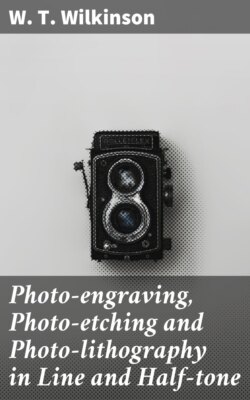Читать книгу Photo-engraving, Photo-etching and Photo-lithography in Line and Half-tone - W. T. Wilkinson - Страница 14
На сайте Литреса книга снята с продажи.
THE USE OF GELATINE DRY PLATES IN PHOTO-ENGRAVING.
ОглавлениеFor making negatives for collographic printing either direct or by transfer, gelatine dry plates may be used with as much certainty as the wet collodion, so long as the operator can produce a result giving all the gradations of tone, from the deepest shadow to the highest light; and as there are so many excellent brands of plates in the market, it would be worse than useless to name any brand here as having any distinct advantage over the rest, more especially as the brand that the writer would be inclined to name, would perhaps, by the majority of readers, be classed as a plate that they could not work. This being so, for half-tone negatives, the author leaves the choice of the plate and the manner of working to the operator, contenting himself with saying that the criterion of suitability of a negative for yielding good results by any of the processes treated of in this book, leaving out of the question entirely negatives for line work, etc. (treated of in Parts I., II., and III.), is the same for giving soft, delicate, and brilliant prints, either in platinum, carbon, or on albumenized paper, resting assured that a negative yielding a hard black and white, or a dirty flat print, by any of these three methods, will not give results any different in collographic or transfer methods.
For line work negatives for printing upon zinc, for etching, or for transfers to stone, ordinary gelatine dry plates are not useful, as it is almost impossible to get that freedom from veil over the lines that it is absolutely necessary to have; here the wet collodion is best as it is simplest, easiest, and cheapest. {30} Still there are times when the most ardent wet-plate worker is obliged to confess that the process has its shortcomings, most especially in dull weather, when it is necessary, to get the result required, to give exposures from thirty to sixty minutes; then, what with the plate drying and the want of pluck from the bad light, it is impossible to get a result suitable for the work. In this case the plate called the “Process” plate is a great boon. It is fairly rapid, and gives intense negatives, without veil on the lines.
For making transparencies same size of original negatives, the best plan is to place a large sheet of white paper in front of the copying camera, and rack the lens out of focus, taking care that the white sheet of paper is sufficient to illuminate the full size of the plate. Then in the dark-room place the negative in the carrier of the dark slide, film side up, and carefully dust the surface (also seeing that the back of the negative is clean) with a clean camel’s-hair brush; dust also the film of a gelatine dry plate, and place it face down upon the negative, close the slide, and insert it into the grooves of the camera and expose to the light reflected through the lens from the white sheet of paper for from five to twenty seconds, according to the density of the negative and the intensity of the light; close the lens and the shutter, and remove it into the dark-room for development.
By exposing a plate in this manner there is a far better chance of getting absolute contact between the two plates, as the rays of light are parallel.
For making transparencies for printing upon copper-plates, first of all make a grained negative the proper size, then when this is varnished and touched up, make from it as above a transparency upon a gelatine chloride dry plate, by which process it is more certain to get a suitable result for the process than on a gelatine bromide dry plate.
No formula will be given here for developing these gelatine chloride plates as each packet has full instructions for development which must be followed implicitly.
For developing gelatine bromide dry plates for negatives, or for transparencies, the following, a modification of the Ilford formula, will be found better than using formula where the ammonia and bromide are mixed together.
| Solution No. 1. | ||
|---|---|---|
| Pyrogallic Acid | 1 | ounce. |
| Meta Bisulphate of Potash | 1 | ounce. |
| Bromide of Potassium | 1 | ounce. |
| Water | 80 | ounces. |
| Solution No. 2. | ||
| Liquor Ammonia | 1⁄2 | ounce. |
| Water | 10 | ounces. |
For a normal exposure equal parts of these are mixed just before using, and for an uncertain exposure begin with two parts of No. 1, one part of water, and one part of No. 2.
